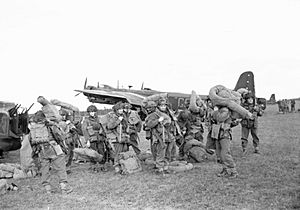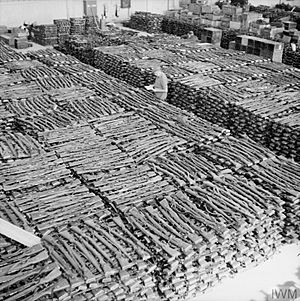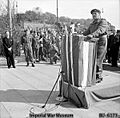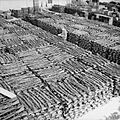Operation Doomsday facts for kids
Quick facts for kids Operation Doomsday |
|||||||
|---|---|---|---|---|---|---|---|
| Part of Second World War Allied occupation of Norway |
|||||||
 British airborne troops, just disembarked from Stirling aircraft at Gardermoen airfield near Oslo |
|||||||
|
|||||||
| Belligerents | |||||||
| Commanders and leaders | |||||||
| Andrew Thorne Roy Urquhart |
Franz Böhme | ||||||
| Units involved | |||||||
| British 1st Airborne Division | German 20th Mountain Army | ||||||
| Strength | |||||||
| 6,000 | ~350,000 | ||||||
| Casualties and losses | |||||||
| 47 killed and injured | All surrendered | ||||||
Operation Doomsday was a special mission by the British 1st Airborne Division in May 1945. This happened right after the Second World War ended in Europe. Their job was to act like police and soldiers during the Allied occupation of Norway.
The division helped keep things peaceful until more Allied troops arrived. They had to make sure German forces in Norway surrendered properly. They also stopped any attempts to damage important buildings or equipment.
Germany officially surrendered on May 8. General Franz Böhme, who led the German forces in Norway, received the surrender order. The 1st Airborne Division then landed near Oslo and Stavanger between May 9 and 11. Most of their planes landed safely, but a few crashed, causing some deaths. Luckily, they didn't face much resistance from the Germans.
Their duties included welcoming back King Haakon VII of Norway. They also helped Allied prisoners of war and arrested war criminals. Another important task was to oversee the clearing of dangerous minefields. The division also found out what happened to British troops from Operation Freshman. This was a failed mission in 1942 to stop Germany's atomic weapons program. The 1st Airborne Division returned to Britain in August and was later disbanded.
Contents
Planning the Mission
Since 1943, the Allies had been planning to occupy Norway after Germany surrendered. This plan was called Operation Apostle. The main force for this, called Force 134, included Norwegian troops from Scotland. It also had British and a few American soldiers. About 12,000 Norwegian police troops, who were in neutral Sweden, were also part of the plan.
General Andrew Thorne was in charge of the Scottish Command. He oversaw the planning for Norway. The Allies considered two main possibilities for how the Germans would react.
One plan, called 'Rankin C (Norway)', assumed all German forces in Norway would surrender peacefully. The other, 'Rankin B', imagined the Germans might resist. They might try to hold onto parts of Norway or even destroy things. Because of these unknowns, the Allies made very detailed and flexible plans.
However, Thorne didn't have many troops for Force 134. Most military resources were being used in other parts of Europe. In September 1944, his original division was sent to another operation. Instead, he was given the 1st Airborne Division. This division was led by Major General Roy Urquhart.
The 1st Airborne Division had suffered many losses in a previous battle. They needed time to get ready again. By May 1945, they were finally prepared. Thorne also planned to rely on Milorg, the Norwegian Resistance. Milorg had about 40,000 members. They were well-trained and armed. They were ready to stop Germans from destroying important places if they resisted.
Getting Ready
Allied Preparations
By early May 1945, the 1st Airborne Division was ready for action. Many new, but less experienced, soldiers had joined. On May 4, Major General Urquhart received new orders. Some of his brigades were sent to other places. However, the rest of the division was told to prepare for Norway.
Urquhart quickly got his division ready in just 48 hours. This was much faster than expected. Once in Norway, the division had several key jobs. They had to keep law and order. They also had to make sure German units followed their surrender terms. Securing airfields and preventing sabotage were also important.
The division was organized into three main groups for this mission. These were the 1st Airlanding Brigade, the Special Air Service Brigade, and an Artillery Brigade.
The 1st Airlanding Brigade would land near Oslo, Norway's capital. They would occupy the city. The Artillery Brigade would land at Stavanger. This airfield was close to Britain and good for fighter planes. The Special Air Service Brigade would also land in Stavanger. From there, they would move to Kristiansand, an important port.
The operation was planned in four phases over four days. On May 8, small advance teams would fly to airfields near Oslo and Stavanger. On May 9, larger groups would arrive. This included the 1st Airlanding Brigade and parts of the division headquarters. On May 10, the Special Air Service Brigade would land. Finally, on May 11, supplies and vehicles would arrive. Before the troops landed, special Allied representatives, called 'Heralds', would go to Norway. They would signal when the airfields were safe.
German Preparations
German forces had been slowly moving out of northern Finland since late 1944. They were retreating into new positions in northern Norway. By early 1945, this retreat was mostly finished.
Grand Admiral Karl Dönitz, who led the German Navy, saw Norway as very important. He wanted to keep using U-boat bases there to fight the Allies. Even Adolf Hitler refused to let German divisions leave Norway to defend Germany. He feared that if they left, neutral Sweden might join the Allies.
Dönitz believed Norway was vital until the very end of the war. On May 3, his naval command said that U-boats would still sail from Norway, even if Germany was occupied. Only on May 4 did the German high command order all troops in Norway to avoid actions that might provoke the Allies.
In May 1945, all German troops in Norway were under the Twentieth Mountain Army. General Franz Böhme was its commander. He reported that his forces had about 350,000 to 380,000 troops. There were also many U-boats in Norway. Despite the war ending in Germany, the German forces in Norway seemed almost at peace. General Bernard Montgomery was initially worried about such a large German force. However, the surrender of Norway was achieved through talks and persuasion.
The Occupation Begins
Arrival in Norway
In the early morning of May 7, Dönitz ordered all German military forces to surrender without conditions. On May 8, the official surrender document was given to General Böhme. The Germans were told to leave all Norwegian towns and move to special areas for disarmament. All high-ranking Nazi officials and security personnel were to be arrested immediately.
Force 134 was much smaller than the German forces. About 30,000 Allied troops had to oversee the surrender of over 350,000 Germans. There were worries that the Germans might refuse to surrender. There were special concerns about the large German Navy group in Trondheim.
The first phase of the operation was delayed by a day. The 'Heralds' couldn't signal that the airfields were clear. But on May 9, contact was made. The first units of Force 134 arrived in Norway. This included parts of the 1st Airborne Division. Almost all planes landed safely.
To make up for the delay, the second phase was sped up. However, bad weather over Oslo on May 9 caused many planes to turn back. Planes going to Stavanger landed successfully. A few planes crash-landed, and one went missing. The remaining planes took off on May 11. One crashed on takeoff, and another went missing. One missing plane landed at another airfield. But the other crashed, killing everyone on board, including Air Vice-Marshal James Scarlett-Streatfeild. The 1st Airborne Division lost 34 soldiers and the Royal Air Force lost 6. All these losses happened after the surrender had been declared.
Duties in Norway
The original plan was for two airborne battalions to march through Oslo on May 10. But because of the delays, only a few troops had arrived by then. Instead, Major General Urquhart rode into Oslo in a captured German car. He was joined by a few soldiers and military police. The soldiers were a bit nervous because their group was so small. But the Norwegian people in Oslo greeted them with great excitement.
The only resistance came from the captains of a few U-boats in Trondheim. Other than that, the 1st Airborne Division had no trouble with the German forces. The Germans cooperated fully. They were disarmed easily and moved to collection camps. They also helped clear many minefields they had placed, which caused some German casualties.
Major General Urquhart and his staff were in charge of all Norwegian activities at first. This was until other Allied units arrived. Urquhart welcomed Crown Prince Olaf of Norway and three government ministers. The division also took part in celebrations when King Haakon VII returned from exile.
Other duties for the division included finding war criminals. They also made sure German troops stayed in their camps. With help from Royal Engineers, they cleared buildings of mines and traps. They also helped Allied personnel who had been prisoners of war in Norway. Many of these were Russian. There were over 80,000 Russian ex-prisoners of war. Many needed medical care because of the terrible conditions in their camps.
In late June, a parade was held to celebrate the Allied liberation. Many Russians took part, wearing uniforms with red star badges they had made themselves. During their time in Norway, about 400 paratroopers helped make Theirs Is the Glory. This was a documentary about the Battle of Arnhem.
The Norwegian resistance worked closely with the 1st Airborne Division. They often helped with communication and guard duties. The Norwegian people welcomed the airborne troops warmly. British forces first controlled Oslo, Stavanger, and Kristiansand. The resistance and local Norwegian authorities took control of the rest of the country from the Germans.
The resistance also helped the division learn what happened to troops from Operation Freshman. This was a failed mission in November 1942. Its goal was to damage a chemical plant that made heavy water for Germany's atomic weapons program. Two gliders crashed during the mission. The survivors were executed after being captured. Local Norwegians could not stop the executions. But they later found the bodies and buried them. When the 1st Airborne Division arrived, they learned about this. They worked with the Norwegian government to build a memorial and bury the fallen men with full military honors.
What Happened Next

More units of Force 134 arrived in Norway throughout May. They slowly reinforced the airborne troops. On May 10, Norwegian police forces began to enter the country from Sweden. These police had been trained from young Norwegians who fled to Sweden in 1940. General Thorne arrived with his headquarters on May 13. He became the Commander-in-Chief of Allied Liberation Forces.
More of Force 134 arrived in the next two weeks. This included an American regiment, a Norwegian brigade, and two British infantry brigades. Thorne was the acting leader of Norway until June 7, when King Haakon returned. Thorne remained in charge of all military forces in Norway until he left in October.
The 1st Airborne Division stayed in Norway until the end of summer. They returned to Britain in late August. Their soldiers were then given leave. The division was originally planned to be a reserve force. But when Japan surrendered in August, another airborne division was no longer needed. This meant there were two airborne divisions but only one was planned for the post-war army.
The 1st Airborne Division was still recovering from its heavy losses. It was not fully trained. So, the division spent two months training and transferring soldiers to the other airborne division. The 1st Airborne Division was then disbanded on November 15, 1945.
Images for kids
-
Storeroom at Sola aerodrome, Stavanger, holding some of the estimated 30,000 rifles taken from German forces in Norway after their surrender




